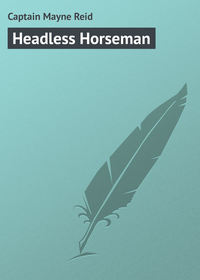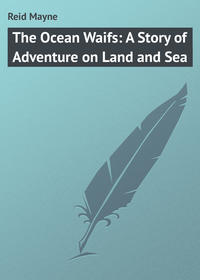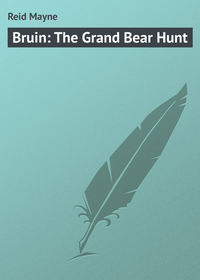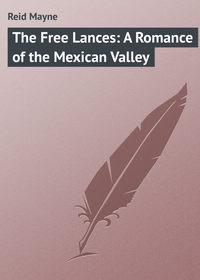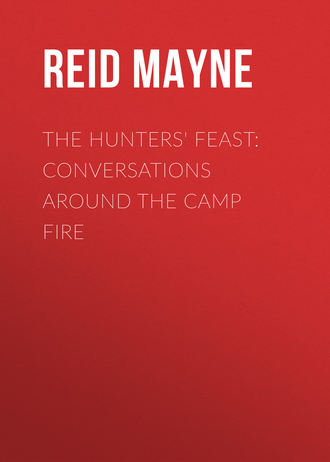 полная версия
полная версияThe Hunters' Feast: Conversations Around the Camp Fire
Chapter Thirty One.
The Buffaloes at last
The long looked for day at length arrived when the game were to be met with, and I had myself the “distinguished honour” of being the first not only to see the great buffalo, but to throw a couple of them “in their tracks.” This incident, however, was not without an “adventure,” and one that was neither very pleasant nor without peril. During several late days of our journey we had been in the habit of straggling a good deal in search of game – deer if we could find it, but more especially in hopes of falling in with the buffalo. Sometimes we went in twos or threes, but as often one of the party rode off alone to hunt wherever his inclination guided him. Sometimes these solitary expeditions took place while the party was on the march, but oftener during the hours after we had pitched our night-camp.
One evening, after we had camped as usual, and my brave horse had eaten his “bite” of corn, I leaped into the saddle and rode off in hopes of finding something fresh for supper. The prairie where we had halted was a “rolling” one, and as the camp had been fixed on a small stream, between two great swells, it was not visible at any great distance. As soon, therefore, as I had crossed one of the ridges, I was out of sight of my companions. Trusting to the sky for my direction, I continued on.
After riding about a mile, I came upon buffalo “sign,” consisting of several circular holes in the ground, five or six feet in diameter, known as buffalo wallows I saw at a glance that the sign was fresh. There were several wallows; and I could tell by the tracks, in the dusk, there had been bulls in that quarter. So I continued on in hopes of getting a sight of the animals that had been wallowing.
Shortly after, I came to a place where the ground was ploughed up, as if a drove of hogs had been rooting it. Here there had been a terrible fight among the bulls – it was the rutting season, when such conflicts occur. This augured well. Perhaps they are still in the neighbourhood, reasoned I, as I gave the spur to my horse, and galloped forward with more spirit.
I had ridden full five miles from camp, when my attention was attracted by an odd noise ahead of me. There was a ridge in front that prevented me from seeing what produced the noise; but I knew what it was – it was the bellowing of a buffalo-bull.
At intervals, there were quick shocks, as of two hard substances coming in violent contact with each other.
I mounted the ridge with caution, and looked over its crest. There was a valley beyond; a cloud of dust was rising out of its bottom, and in the midst of this I could distinguish two huge forms – dark and hirsute.
I saw at once that they were a pair of buffalo-bulls engaged in a fierce fight. They were alone; there were no others in sight, either in the valley or on the prairie beyond.
I did not halt longer than to see that the cap was on my rifle, and to cock the piece. Occupied as the animals were, I did not imagine they would heed me: or, if they should attempt flight, I knew I could easily overtake one or other; so, without farther hesitation or precaution, I rode towards them.
Contrary to my expectation, they both “winded” me, and started off. The wind was blowing freshly towards them, and the sun had thrown my shadow between them, so as to draw their attention.
They did not run, however, as if badly scared; on the contrary, they went off, apparently indignant at being disturbed in their fight; and every now and then both came round with short turnings, snorted, and struck the prairie with their hoofs in a violent and angry manner.
Once or twice, I fancied they were going to charge upon me; and had I been otherwise than well mounted, I should have been very chary of risking such an encounter. A more formidable pair of antagonists, as far as appearance went, could not have been well conceived. Their huge size, their shaggy fronts, and fierce glaring eyeballs, gave them a wild and malicious seeming, which was heightened by their bellowing, and the threatening attitudes in which they continually placed themselves.
Feeling quite safe in my saddle, I galloped up to the nearest, and sent my bullet into his ribs. It did the work. He fell to his knees – rose again – spread out his legs, as if to prevent a second fall – rocked from side to side like a cradle – again came to his knees; and after remaining in this position for some minutes, with the blood running from his nostrils, rolled quietly over on his shoulder, and lay dead.
I had watched these manoeuvres with interest, and permitted the second bull to make his escape; a side-glance had shown me the latter disappearing over the crest of the swell.
I did not care to follow him, as my horse was somewhat jaded, and I knew it would cost me a sharp gallop to come up with him again; so I thought no more of him at that time, but alighted, and prepared to deal with the one already slain.
There stood a solitary tree near the spot – it was a stunted cotton-wood. There were others upon the prairie, but they were distant; this one was not twenty yards from the carcass. I led my horse up to it, and taking the trail-rope from the horn of the saddle, made one end fast to the bit-ring, and the other to the tree. I then went back, drew my knife, and proceeded to cut up the buffalo.
I had hardly whetted my blade, when a noise from behind caused me to leap to an upright attitude, and look round; at the first glance, I comprehended the noise. A huge dark object was passing the crest of the ridge, and rushing down the hill towards the spot where I stood. It was the buffalo-bull, the same that had just left me.
The sight, at first thought, rather pleased me than otherwise. Although I did not want any more meat, I should have the triumph of carrying two tongues instead of one to the camp. I therefore hurriedly sheathed my knife, and laid hold of my rifle, which, according to custom, I had taken the precaution to re-load.
I hesitated a moment whether to run to my horse and mount him, or to fire from where I stood. That question, however, was settled by the buffalo. The tree and the horse were to one side of the direction in which he was running, but being attracted by the loud snorting of the horse, which had begun to pitch and plunge violently, and deeming it perhaps a challenge, the buffalo suddenly swerved from his course, and ran full tilt upon the horse. The latter shot out instantly to the full length of the trail-rope – a heavy “pluck” sounded in my ears, and the next instant I saw my horse part from the tree, and scour off over the prairie, as if there had been a thistle under his tail. I had knotted the rope negligently upon the bit-ring, and the knot had “come undone.”
I was chagrined, but not alarmed as yet. My horse would no doubt follow back his own trail, and at the worst I should only have to walk to the camp. I should have the satisfaction of punishing the buffalo for the trick he had served me; and with this design I turned towards him.
I saw that he had not followed the horse, but was again heading himself in my direction.
Now, for the first time, it occurred to me that I was in something of a scrape. The bull was coming furiously on. Should my shot miss, or even should it only wound him, how was I to escape? I knew that he could overtake me in a three minutes’ stretch; I knew that well.
I had not much time for reflection – not a moment, in fact: the infuriated animal was within ten paces of me. I raised my rifle, aimed at his fore-shoulder, and fired.
I saw that I had hit him; but, to my dismay, he neither fell nor stumbled, but continued to charge forward more furiously than ever.
To re-load was impossible. My pistols had gone off with my horse and holsters. Even to reach the tree was impossible; the bull was between it and me.
To make off in the opposite direction was the only thing that held out the prospect of five minutes’ safety; I turned and ran.
I can run as fast as most men, and upon that occasion I did my best. It would have put “Gildersleeve” into a white sweat to have distanced me; but I had not been two minutes at it, when I felt conscious that the buffalo gained upon me, and was almost treading upon my heels! I knew it only by my ears – I dared not spare time to look back.
At this moment, an object appeared before me, that promised, one way or another, to interrupt the chase; it was a ditch or gully, that intersected my path at right angles. It was several feet in depth, dry at the bottom, and with perpendicular sides.
I was almost upon its edge before I noticed it, but the moment it came under my eye, I saw that it offered the means of a temporary safety at least. If I could only leap this gully, I felt satisfied that the buffalo could not.
It was a sharp leap – at least, seventeen feet from cheek to cheek; but I had done more than that in my time; and, without halting in my gait, I ran forward to the edge, and sprang over.
I alighted cleverly upon the opposite bank, where I stopped, and turned round to watch my pursuer.
I now ascertained how near my end I had been: the bull was already up to the very edge of the gully. Had I not made my leap at the instant I did, I should have been by that time dancing upon his horns. He himself had balked at the leap; the deep chasm-like cleft had cowed him. He saw that he could not clear it; and now stood upon the opposite bank with head lowered, and spread nostrils, his tail lashing his brown flanks, while his glaring black eyes expressed the full measure of his baffled rage.
I remarked that my shot had taken effect in his shoulder, as the blood trickled from his long hair.
I had almost begun to congratulate myself on having escaped, when a hurried glance to the right, and another to the left, cut short my happiness. I saw that on both sides, at a distance of less than fifty paces, the gully shallowed out into the plain, where it ended; at either end it was, of course, passable.
The bull observed this almost at the same time as myself; and, suddenly turning away from the brink, he ran along the edge of the chasm, evidently with the intention of turning it.
In less than a minute’s time we were once more on the same side, and my situation appeared as terrible as ever; but, stepping back for a short run, I re-leaped the chasm, and again we stood on opposite sides.
During all these manoeuvres I had held on to my rifle; and, seeing now that I might have time to load it, I commenced feeling for my powder-horn. To my astonishment, I could not lay my hands upon it: I looked down to my breast for the sling – it was not there; belt and bullet-pouch too – all were gone! I remembered lifting them over my head, when I set about cutting the dead bull. They were lying by the carcass.
This discovery was a new source of chagrin; but for my negligence, I could now have mastered my antagonist.
To reach the ammunition would be impossible; I should be overtaken before I had got half-way to it.
I was not allowed much time to indulge in my regrets; the bull had again turned the ditch, and was once more upon the same side with me, and I was compelled to take another leap.
I really do not remember how often I sprang backwards and forwards across that chasm; I should think a dozen times at least, and I became wearied with the exercise. The leap was just as much as I could do at my best; and as I was growing weaker at each fresh spring, I became satisfied that I should soon leap short, and crush myself against the steep rocky sides of the chasm.
Should I fall to the bottom, my pursuer could easily reach me by entering at either end, and I began to dread such a finale. The vengeful brute showed no symptoms of retiring; on the contrary, the numerous disappointments seemed only to render him more determined in his resentment.
An idea now suggested itself to my mind, I had looked all round to see if there might not be something that offered a better security. There were trees, but they were too distant: the only one near was that to which my horse had been tied. It was a small one, and, like all of its species (it was a cotton-wood), there were no branches near the root.
I knew that I could clamber up it by embracing the trunk, which was not over ten inches in diameter. Could I only succeed in reaching it, it would at least shelter me better than the ditch, of which I was getting heartily tired.
But the question was, could I reach it before the bull?
It was about three hundred yards off. By proper manoeuvring, I should have a start of fifty. Even, with that, it would be a “close shave;” and it proved so.
I arrived at the tree, however, and sprang up it like a mountebank; but the hot breath of the buffalo steamed after me as I ascended, and the concussion of his heavy skull against the trunk almost shook me back upon his horns.
After a severe effort of climbing, I succeeded in lodging myself among the branches.
I was now safe from all immediate danger, but how was the affair to end?
I knew from the experience of others, that my enemy might stay for hours by the tree – perhaps for days!
Hours would be enough. I could not stand it long. I already hungered, but a worse appetite began to torture me: thirst. The hot sun, the dust, the violent exercise of the past hour, all contributed to make me thirsty. Even then, I would have risked life for a draught of water. What would it come to should I not be relieved?
I had but one hope – that my companions would come to my relief; but I knew that that would not be before morning. They would miss me of course. Perhaps my horse would return to camp – that would send them out in search for me – but not before night had fallen. In the darkness they could not follow my trail. Could they do so in the light?
This last question, which I had put to myself, startled me. I was just in a condition to look upon the dark side of everything, and it now occurred to me that they might not be able to find me!
There were many possibilities that they might not. There were numerous horse-trails on the prairie, where Indians had passed. I saw this when tracking the buffalo. Besides, it might rain in the night, and obliterate them all – my own with the rest. They were not likely to find me by chance. A circle of ten miles diameter is a large tract. It was a rolling prairie, as already stated, full of inequalities, ridges with valleys between. The tree upon which I was perched stood in the bottom of one of the valleys – it could not be seen from any point over three hundred yards distant. Those searching for me might pass within hail without perceiving either the tree or the valley.
I remained for a long time busied with such gloomy thoughts and forebodings. Night was coming on, but the fierce and obstinate brute showed no disposition to raise the siege. He remained watchful as ever, walking round and round at intervals, lashing his tail, and uttering that snorting sound so well-known, to the prairie-hunter, and which so much resembles the grunting of hogs when suddenly alarmed. Occasionally he would bellow loudly like the common bull.
While watching his various manoeuvres, an object on the ground drew my attention – it was the trail-rope left by my horse. One end of it was fastened round the trunk by a firm knot – the other lay far out upon the prairie, where it had been dragged. My attention had been drawn to it by the bull himself, that in crossing over it had noticed it, and now and then pawed it with his hoofs.
All at once a bright idea flashed upon me – a sudden hope arose within me – a plan of escape presented itself, so feasible and possible, that I leaped in my perch as the thought struck me.
The first step was to get possession of the rope. This was not such an easy matter. The rope was fastened around the tree, but the knot had slipped down the trunk and lay upon the ground. I dared not descend for it.
Necessity soon suggested a plan.
My “picker” – a piece of straight wire with a ring-end – hung from one of my breast buttons. This I took hold of, and bent into the shape of a grappling-hook. I had no cord, but my knife was still sate in its sheath; and, drawing this, I cut several thongs from the skirt or my buckskin shirt, and knotted them together until they formed a string long enough to reach the ground. To one end I attached the picker; and then letting it down, I commenced angling for the rope.
After a few transverse drags, the hook caught the latter, and I pulled it up into the tree, taking the whole of it in until I held the loose end in my hands. The other end I permitted to remain as it was; I saw it was securely knotted around the trunk, and that was just what I wanted.
It was my intention to lasso the bull; and for this purpose I proceeded to make a running-noose on the end of the trail-rope.
This I executed with great care, and with all my skill. I could depend upon the rope; it was raw hide, and a hotter was never twisted; but I knew that if anything should chance to slip at a critical moment, it might cost me my life. With this knowledge, therefore, I spliced the eye, and made the knot as firm as possible, and then the loop was reeved through, and the thing was ready.
I could throw a lasso tolerably well, but the branches prevented me from winding it around my head. It was necessary, therefore, to get the animal in a certain position under the tree, which, by shouts and other demonstrations, I at length succeeded in effecting.
The moment of success had arrived. He stood almost directly below me. The noose was shot down – I had the gratification to see it settle around his neck; and with a quick jerk I tightened it. The rope ran beautifully through the eye, until both eye and loop were buried beneath the shaggy hair of the animal’s neck. It embraced his throat in the right place, and I felt confident it would hold.
The moment the bull felt the jerk upon his throat, he dashed madly out from the tree, and then commenced running in circles around it.
Contrary to my intention, the rope had slipped from my hands at the first drag upon it. My position was rather an unsteady one, for the branches were slender, and I could not manage matters as well as I could have wished.
But I now felt confident enough. The bull was tethered, and it only remained for me to get out beyond the length of his tether, and take to my heels.
My gun lay on one side, near the tree, where I had dropped it in my race: this, of course, I meant to carry off with me.
I waited then until the animal, in one of his circles, had got round to the opposite side, and slipping silently down the trunk, I sprang out, picked up my rifle, and ran.
I knew the trail-rope to be about twenty yards in length, but I ran a hundred, at least, before making halt. I had even thoughts of continuing on, as I still could not help some misgivings about the rope.
The bull was one of the largest and strongest. The rope might break, the knot upon the tree might give way, or the noose might slip over his head.
Curiosity, however, or rather a desire to be assured of my safety, prompted me to look around, when, to my joy, I beheld the huge monster stretched upon the plain. I could see the rope as taut as a bow-string; and the tongue protruding from the animal’s jaws showed me that he was strangling himself as fast as I could desire.
At the sight, the idea of buffalo-tongue for supper returned in all its vigour; and it now occurred to me that I should eat that very tongue, and no other.
I immediately turned in my tracks, ran towards my powder and balls – which, in my eagerness to escape, I had forgotten all about – seized the horn and pouch, poured in a charge, rammed down a bullet, and then stealing nimbly up behind the still struggling bull, I placed the muzzle within three feet of his brisket, and fired. He gave a death-kick or two, and then lay quiet: it was all over with him.
I had the tongue from between his teeth in a twinkling; and proceeding to the other bull, I finished the operations I had commenced upon him. I was too tired to think of carrying a very heavy load; so I contented myself with the tongues, and slinging these over the barrel of my rifle, I shouldered it, and set out to grope my way back to camp.
The moon had risen, and I had no difficulty in following my own trail; but before I had got half-way, I met several of my companions shouting, and at intervals firing off their guns.
My horse had got back a little before sunset. His appearance had, of course, produced alarm, and the camp had turned out in search of me.
Several who had a relish for fresh meat galloped back to strip the two bulls of the remaining tit-bits; but before midnight all had returned; and to the accompaniment of the hump-ribs spurting in the cheerful blaze, I recounted the details of my adventure.
Chapter Thirty Two.
The Bison
The bison – universally, though improperly, called buffalo – is, perhaps, the most interesting animal in America. Its great size and strength – the prodigious numbers in which it is found – its peculiar habitat– the value of its flesh and hide to the traveller, as well as to the many tribes of Indians – the mode of its chase and capture – all these circumstances render the buffalo an interesting and highly-prized animal.
Besides, it is the largest ruminant indigenous to America, exceeding in weight even the moose-deer, which latter, however, equals it in height. With the exception of the musk-ox, it is the only indigenous animal of the bovine tribe, but the latter being confined to a very limited range, near the Arctic Sea, has been less subject to the observation and attention of the civilised world. The buffalo, therefore, may be regarded as the representative of the ox in America.
The appearance of the animal is well-known; pictorial illustration has rendered it familiar to the eyes of every one. The enormous head, with its broad triangular front – the conical hump on the shoulders – the small but brilliantly-piercing eyes – the short black horns, of crescent shape – the profusion of shaggy hair about, the neck and foreparts of the body – the disproportioned bulk of the smaller hind-quarters – the short tail, with its tufted extremity; all these are characteristics. The hind-quarters are covered with a much shorter and smoother coat of hair, which adds to their apparent disproportion, and this, with the long hirsute covering of the breast, neck, hump, and shoulders, gives to the buffalo – especially when seen in a picture – a somewhat lion-like figure. The naked tail, with its tuft at the end, strengthens this similarity.
Some of the characteristics above enumerated belong only to the bull. The cow is less shaggy in front, has a smaller head, a less fierce appearance, and is altogether more like the common black cattle.
The buffalo is of a dark brown colour – sometimes nearly black – and sometimes of a burnt or liver hue; but this change depends on the season. The young coat of hair is darker, but changes as the season advances. In autumn it is nearly black, and then the coat of the animal has a shiny appearance; but as winter comes on, and the hair lengthens, it becomes lighter and more bleached-like. In the early part of summer it has a yellowish brown hue, and at this time, with rubbing and wallowing, part of it has already come off, while large flakes hang raggled and loose from the flanks, ready at any moment to drop off.
In size, the American buffalo competes with the European species (Bos aurochs), now nearly extinct. These animals differ in shape considerably, but the largest individuals of each species would very nearly balance one another in weight. Either of them is equal in size and weight to the largest specimens of the common ox – prize oxen, of course, excepted.
A full-grown buffalo-bull is six feet high at the shoulders, eight feet from the snout to the base of the tail, and will weigh about 1500 pounds.
Rare individuals exist whose weight much exceeds this. The cows are, of course, much smaller than the bulls, and scarcely come up to the ordinary standard of farm-cattle.
The flesh of the buffalo is juicy and delicious, equal, indeed superior, to well-fed beef. It may be regarded as beef with a game flavour.
Many people – travellers and hunters – prefer it to any other species of meat.
The flesh of the cow, as may be supposed, is more tender and savoury than that of the bull; and in a hunt when “meat” is the object, the cow is selected as a mark for the arrow or bullet.




